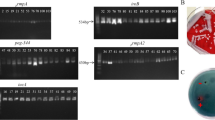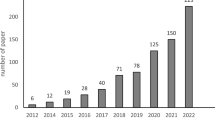Abstract
Distinguishing between hypervirulent Klebsiella pneumoniae (hvKp) and classical Klebsiella pneumoniae (cKp) is a challenge to clinical laboratories. The aim of this study was to determine the practicability of combining the G. mellonella killing assay with a string test to differentiate hvKp from cKp. One hundred and three clinical K. pneumoniae isolates were collected. PCR amplification and wzi sequencing were used to determine the capsular serotype. Virulence genes allS, iro, iuc, and rmpA2, used frequently to identify hvKp, were detected by PCR. The virulence of K. pneumoniae isolates was evaluated using the following assays in parallel: molecular markers detection, G. mellonella killing assay alone, G. mellonella killing assay combined with the string test, and mouse infection. The results showed that the sensitivity, specificity, positive predictive value, and negative predictive value of combining the G. mellonella killing assay with a string test were 95.56%, 94.83%, 93.48%, and 96.49%, respectively, compared with mouse infection used as a positive reference. These values were significantly greater than those obtained using the G. mellonella killing assay only. The sensitivity, specificity, positive predictive value, and negative predictive value of allS, iro, iuc, and rmpA2 were greater than 77.78%, but less than combining the G. mellonella killing assay and string test. G. mellonella killing assay used in conjugation with the string test is a relatively simple and accurate method to assess K. pneumoniae virulence and differentiate between hvKp and cKp.


Similar content being viewed by others
References
Liu YC, Cheng DL, Lin CL (1986) Klebsiella pneumoniae liver abscess associated with septic endophthalmitis. Arch Intern Med 146(10):1913–1916
Yeoh KG, Yap I, Wong ST, Wee A, Guan R, Kang JY (1997) Tropical liver abscess. Postgrad Med J 73(856):89–92
Chung DR, Lee SS, Lee HR, Kim HB, Choi HJ, Eom JS, Kim JS, Choi YH, Lee JS, Chung MH, Kim YS, Lee H, Lee MS, Park CK, Korean Study Group for Liver A (2007) Emerging invasive liver abscess caused by K1 serotype Klebsiella pneumoniae in Korea. J Inf Secur 54(6):578–583. https://doi.org/10.1016/j.jinf.2006.11.008
Li W, Sun G, Yu Y, Li N, Chen M, Jin R, Jiao Y, Wu H (2014) Increasing occurrence of antimicrobial-resistant hypervirulent (hypermucoviscous) Klebsiella pneumoniae isolates in China. Clin Infect Dis 58(2):225–232. https://doi.org/10.1093/cid/cit675
Harris PJ, Laczek JT, Polish RD, Fraser SL (2005) Two cases of Klebsiella pneumoniae primary liver abscesses; an emerging clinical entity among diabetics. Hawaii Med J 64(12):306–307 325
Decre D, Verdet C, Emirian A, Le Gourrierec T, Petit JC, Offenstadt G, Maury E, Brisse S, Arlet G (2011) Emerging severe and fatal infections due to Klebsiella pneumoniae in two university hospitals in France. J Clin Microbiol 49(8):3012–3014. https://doi.org/10.1128/JCM.00676-11
Siu LK, Yeh KM, Lin JC, Fung CP, Chang FY (2012) Klebsiella pneumoniae liver abscess: a new invasive syndrome. Lancet Infect Dis 12(11):881–887. https://doi.org/10.1016/S1473-3099(12)70205-0
Russo TA, Marr CM (2019) Hypervirulent Klebsiella pneumoniae. Clin Microbiol Rev 32(3). https://doi.org/10.1128/CMR.00001-19
Tan TY, Cheng Y, Ong M, Ng LS (2014) Performance characteristics and clinical predictive value of the string test for detection of hepato-virulent Klebsiella pneumoniae isolated from blood cultures. Diagn Microbiol Infect Dis 78(2):127–128. https://doi.org/10.1016/j.diagmicrobio.2013.10.014
Zhang Y, Zeng J, Liu W, Zhao F, Hu Z, Zhao C, Wang Q, Wang X, Chen H, Li H, Zhang F, Li S, Cao B, Wang H (2015) Emergence of a hypervirulent carbapenem-resistant Klebsiella pneumoniae isolate from clinical infections in China. J Inf Secur 71(5):553–560. https://doi.org/10.1016/j.jinf.2015.07.010
Zhu J, Yin X, Xi W, Zhao R, Li M (2017) Emergence of low virulent carbapenem-resistant hypermucoviscous Klebsiella pneumoniae in China. J Inf Secur 75(5):469–472. https://doi.org/10.1016/j.jinf.2017.07.009
Russo TA, Olson R, Fang CT, Stoesser N, Miller M, MacDonald U, Hutson A, Barker JH, La Hoz RM, Johnson JR (2018) Identification of biomarkers for differentiation of hypervirulent Klebsiella pneumoniae from classical K. pneumoniae. J Clin Microbiol 56(9). https://doi.org/10.1128/jcm.00776-18
Russo TA, MacDonald U (2020) The Galleria mellonella infection model does not accurately differentiate between hypervirulent and classical Klebsiella pneumoniae. mSphere 5 (1). doi:https://doi.org/10.1128/mSphere.00850-19
Compain F, Babosan A, Brisse S, Genel N, Audo J, Ailloud F, Kassis-Chikhani N, Arlet G, Decre D (2014) Multiplex PCR for detection of seven virulence factors and K1/K2 capsular serotypes of Klebsiella pneumoniae. J Clin Microbiol 52(12):4377–4380. https://doi.org/10.1128/JCM.02316-14
Yu F, Lv J, Niu S, Du H, Tang YW, Pitout JDD, Bonomo RA, Kreiswirth BN, Chen L (2018) Multiplex PCR analysis for rapid detection of Klebsiella pneumoniae carbapenem-resistant (sequence type 258 [ST258] and ST11) and hypervirulent (ST23, ST65, ST86, and ST375) strains. J Clin Microbiol 56(9). https://doi.org/10.1128/JCM.00731-18
Gu D, Dong N, Zheng Z, Lin D, Huang M, Wang L, Chan EW, Shu L, Yu J, Zhang R, Chen S (2018) A fatal outbreak of ST11 carbapenem-resistant hypervirulent Klebsiella pneumoniae in a Chinese hospital: a molecular epidemiological study. Lancet Infect Dis 18(1):37–46. https://doi.org/10.1016/S1473-3099(17)30489-9
Huang Y, Li J, Gu D, Fang Y, Chan EW, Chen S, Zhang R (2015) Rapid detection of K1 hypervirulent Klebsiella pneumoniae by MALDI-TOF MS. Front Microbiol 6:1435. https://doi.org/10.3389/fmicb.2015.01435
Russo TA, Olson R, Macdonald U, Metzger D, Maltese LM, Drake EJ, Gulick AM (2014) Aerobactin mediates virulence and accounts for increased siderophore production under iron-limiting conditions by hypervirulent (hypermucoviscous) Klebsiella pneumoniae. Infect Immun 82(6):2356–2367. https://doi.org/10.1128/IAI.01667-13
Hsieh PF, Hsu CR, Chen CT, Lin TL, Wang JT (2016) The Klebsiella pneumoniae YfgL (BamB) lipoprotein contributes to outer membrane protein biogenesis, type-1 fimbriae expression, anti-phagocytosis, and in vivo virulence. Virulence 7(5):587–601. https://doi.org/10.1080/21505594.2016.1171435
Rosen DA, Twentyman J, Hunstad DA (2018) High levels of cyclic Di-GMP in Klebsiella pneumoniae attenuate virulence in the lung. Infect Immun 86(2). https://doi.org/10.1128/IAI.00647-17
Tsai CJ, Loh JM, Proft T (2016) Galleria mellonella infection models for the study of bacterial diseases and for antimicrobial drug testing. Virulence 7(3):214–229. https://doi.org/10.1080/21505594.2015.1135289
Insua JL, Llobet E, Moranta D, Perez-Gutierrez C, Tomas A, Garmendia J, Bengoechea JA (2013) Modeling Klebsiella pneumoniae pathogenesis by infection of the wax moth Galleria mellonella. Infect Immun 81(10):3552–3565. https://doi.org/10.1128/IAI.00391-13
Diago-Navarro E, Chen L, Passet V, Burack S, Ulacia-Hernando A, Kodiyanplakkal RP, Levi MH, Brisse S, Kreiswirth BN, Fries BC (2014) Carbapenem-resistant Klebsiella pneumoniae exhibit variability in capsular polysaccharide and capsule associated virulence traits. J Infect Dis 210(5):803–813. https://doi.org/10.1093/infdis/jiu157
Yu VL, Hansen DS, Ko WC, Sagnimeni A, Klugman KP, von Gottberg A, Goossens H, Wagener MM, Benedi VJ, International Klebseilla Study G (2007) Virulence characteristics of Klebsiella and clinical manifestations of K. pneumoniae bloodstream infections. Emerg Infect Dis 13(7):986–993. https://doi.org/10.3201/eid1307.070187
Lee HC, Chuang YC, Yu WL, Lee NY, Chang CM, Ko NY, Wang LR, Ko WC (2006) Clinical implications of hypermucoviscosity phenotype in Klebsiella pneumoniae isolates: association with invasive syndrome in patients with community-acquired bacteraemia. J Intern Med 259(6):606–614. https://doi.org/10.1111/j.1365-2796.2006.01641.x
Wang X, Xie Y, Li G, Liu J, Li X, Tian L, Sun J, Ou HY, Qu H (2018) Whole-genome-sequencing characterization of bloodstream infection-causing hypervirulent Klebsiella pneumoniae of capsular serotype K2 and ST374. Virulence 9(1):510–521. https://doi.org/10.1080/21505594.2017.1421894
Brisse S, Passet V, Haugaard AB, Babosan A, Kassis-Chikhani N, Struve C, Decre D (2013) wzi gene sequencing, a rapid method for determination of capsular type for Klebsiella strains. J Clin Microbiol 51(12):4073–4078. https://doi.org/10.1128/JCM.01924-13
Lai YC, Peng HL, Chang HY (2003) RmpA2, an activator of capsule biosynthesis in Klebsiella pneumoniae CG43, regulates K2 cps gene expression at the transcriptional level. J Bacteriol 185(3):788–800. https://doi.org/10.1128/jb.185.3.788-800.2003
Luo Y, Wang Y, Ye L, Yang J (2014) Molecular epidemiology and virulence factors of pyogenic liver abscess causing Klebsiella pneumoniae in China. Clin Microbiol Infect 20(11):O818–O824. https://doi.org/10.1111/1469-0691.12664
Catalan-Najera JC, Garza-Ramos U, Barrios-Camacho H (2017) Hypervirulence and hypermucoviscosity: two different but complementary Klebsiella spp. phenotypes? Virulence 8(7):1111–1123. https://doi.org/10.1080/21505594.2017.1317412
Acknowledgments
Dr. Stephen H. Gregory (Providence, Rhode Island, USA) helped write and edit this manuscript.
Funding
This study was supported by grants from the Technology Commission of Shanghai Municipality (17411961700), Shanghai Municipal Health Commission (201640130).
Author information
Authors and Affiliations
Contributions
GL, XFJ, and YL conceived the study. GL, JMS, YZ, YT, YZ, and YZX performed the experiments and analyzed the data. XFJ and YL supervised the study.
Corresponding authors
Ethics declarations
Ethics statement
Animal studies were performed in accordance with “Guide for the Care and Use of Laboratory Animals” (8th Ed.) and the protocol approved by Shanghai Public Health Clinical Center’s Animal Care and Use Committee.
Conflict of interest
The authors declare that they have no conflicts of interest to declare.
Additional information
Publisher’s note
Springer Nature remains neutral with regard to jurisdictional claims in published maps and institutional affiliations.
Electronic supplementary material
ESM 1
(XLSX 15 kb)
Rights and permissions
About this article
Cite this article
Li, G., Shi, J., Zhao, Y. et al. Identification of hypervirulent Klebsiella pneumoniae isolates using the string test in combination with Galleria mellonella infectivity. Eur J Clin Microbiol Infect Dis 39, 1673–1679 (2020). https://doi.org/10.1007/s10096-020-03890-z
Received:
Accepted:
Published:
Issue Date:
DOI: https://doi.org/10.1007/s10096-020-03890-z




